I’ve been running for most of my life. I started training for the cross-country team when I was 13 and never stopped. Ten miles a week, 52 weeks a year, and 15 years later I’ve run at least 8,000 miles. Probably more like 10,000 when you factor in the long runs, the half marathons, the heavy training periods.
When we were in high school, our coach used to read aloud to us from Once A Runner, to psych us up before races. I’ve never actually read the book, but the title echoes through my head all the time – it resonates. Running is such an essential part of who I am. It’s when I’m running that I feel most like myself, most in tune with my own thoughts. It’s my quiet time, the time when I allow my thoughts to spin unstructured through my mind and let them sort themselves out. When I’m angry I come back calm, and when I’m tired I come back reinvigorated. I’ve made my most difficult decisions in the space of 4 miles without even realizing I was making them.
Running has also taken me to corners of the world where I’d never find myself otherwise. Sunrise runs in Dublin along the quiet banks of the grand canal, past medeival cathedrals and castles. Hot, impossibly humid runs in Hong Kong along an elevated running track in the jungle, looking straight into the tops of skyscrapers. Just a month ago, we set out from Evora into the Alentejan countryside and found ourselves on a dirt path, running through olive and cork groves. It’s the most amazing way to explore somewhere new.
Don’t get me wrong – there are times when running is an absolute slog. When it’s hot and hard to breathe and I heave myself around the streets feeling like I weigh 100 pounds more than I do. But it’s not those times that keep me coming back. It’s the times when it’s cool and quiet and I feel strong and light. It’s the feeling of strength in my legs as my feet bounce repeatedly off the pavement. The sound of my breath in my chest, even and heavy, condensing in clouds around my face when it’s cold. The moment when I hit the second mile, which is always faster, looser than the first.
That steadiness, that strength and clarity, that feeling of self is why I keep running. It’s why I pull on fleece-lined leggings when there’s a wind chill of 0°F. Why I groggily lace up my shoes before dawn and run through the sunrise before my mind is even awake. Why I push through the awful runs and anticipate the great ones. Like they say, once a runner.
I’m writing this as part of my #EatSmarterMoveMore resolution this year. The “eat smart” part is so important to being able to feel good on a run. Running requires fuel – a mix of protein and carbohydrates – and nothing too heavy or rich. My parents used to host dinners for our team the night before we raced, and the living room would fill with skinny teenage girls who ate bowl after bowl of soup and homemade bread. Now that we’re getting into spring running, when the sidewalks are free of ice and my fingers don’t freeze during the first mile, I’m craving light, bright flavors as fuel. So I put together a falafel salad, dressed up for spring with bright, crunchy asparagus and carrot pickles, pistachios, feta and a green herb aioli.
I’ve posted falafel recipes before – it was one of my first posts ever, and I shared this healthy Baked Herb and Pistachio Falafel from Green Kitchen Stories. But to be honest, baked falafel is just not the same. I don’t deep fry mine, I just pan fry them in a little olive oil, which works beautifully. I’ve also started using a 50-50 mix of fava beans and chickpeas, which gives the falafel more flavor and heft.
Like what you just read? Subscribe to Katie at the Kitchen Door in the box on the right, on Feedly or Bloglovin‘, or follow along on Facebook, Twitter, Pinterest, and Instagram. Thanks for reading!
Spring Falafel Salad
Serves 4.
- 5 oz. baby spinach leaves
- 3 oz. swiss chard leaves, torn into bite-sized pieces
- 1 recipe Fava Bean and Chickpea Falafel, recipe below
- 1 cup roughly chopped Spring Pickles, recipe below
- 1/2 cup crumbled feta cheese
- 3/4 cup shelled pistachios, roughly chopped
- 1/2 cup Fresh Herb Aioli
- Mix spinach and chard leave together and divide between four bowls. Top each bowl with 4-5 pieces of falafel, 1/4 cup of spring pickles, 2 tablespoons of feta cheese, and 3 tabplesoons of chopped pistachios. Drizzle a few tablespoons of aioli on top of each bowl and serve.
Fava Bean and Chickpea Falafel
Adapted loosely from Epicurious. Serves 4.
- 1/2 onion, peeled and cut into chunks
- 4 cloves garlic
- 1 c. cooked chickpeas
- 1 c. cooked fava beans (originally dried)
- 1 cup fresh parsley leaves
- 1 tsp ground cumin
- 1/2 tsp ground coriander
- 1/4 tsp sea salt
- 1 tsp baking powder
- 4 TBS flour
- 1/4 cup olive oil, for frying
- Add onion, garlic, half of the chickpeas, half of the fava beans, and the parsley leaves to a food processor. Pulse until the mixture is finely and evenly chopped, but not quite a paste. Add the remaining chickpeas and fava beans to the food processor, and pulse a few times more – most of the mixture should be smooth with a few larger pieces of bean left intact.
- Scrape the bean mixture into a bowl and stir in the ground cumin, ground coriander, sea salt, and baking powder until evenly mixed. Add the flour and stir. Form a small ball of dough with your hands – if the dough comes together easily without sticking to your hands, it’s ready. If not, add another 1 to 2 TBS of flour. Refrigerate the dough for 30 minutes.
- When ready to cook, heat the olive oil in a small frying pan over medium heat. Form the falafel dough into balls roughly the size of a golf ball. Add 5 or 6 of the falafel to the pan and fry until deep golden brown on each side, using tongs to gently turn them as each side cooks. Each batch of falafel will take 5-7 minutes to cook completely. Use tongs to remove the falafel to a paper-towel lined plate. Repeat until you have cooked all of the falafel. Serve immediately.
Spring Pickles – Asparagus, Carrot, Radish, and Swiss Chard
Adapted from Splendid Table. Makes 2 quarts of pickles.
- 10 thin spring carrots
- 20 pencil-thin stalks of asparagus
- 8 swiss chard stems
- 10-12 radishes
- 4 cloves garlic, peeled and thinly sliced
- 2 1/2 cups of white wine vinegar
- 2 1/2 cups of water
- 1/4 cup of honey
- 1/4 cup of kosher salt
- 1 TBS dill seeds
- Bring a large pot water to a boil. Thoroughly clean two quart-size canning jars and fill with very hot water. Set aside.
- Cut the greens from the carrots and discard or reserve for another use. Wash the carrots. If the carrots are thinner than a sharpie marker, leave whole (cutting in half cross-wise only if they are taller than your pickling jars). If they are much thicker, cut them in half lengthwise. When the water is boiling, add the carrots to the water and blanch for 1-2 minutes, then drain them and run the carrots under cold water for 1-2 minutes.
- Wash the asparagus stalks and cut in half cross-wise. Wash the chard stems and slice in half length-wise. All of your long vegetables (carrots, asparagus, chard stems) should be roughly the same length and width. Wash the radishes and cut in half.
- Empty the canning jars of the hot water. Divide the vegetables between the two jars, standing the long vegetables up inside the jars and filling the gaps in with radishes. Add some of the garlic slices to each jar. Pack the jars as full as you can, and make them pretty!
- Add the white wine vinegar, 2 1/2 cups of water, honey, kosher salt, and dill seeds to a small saucepan. Stir to combine. Bring to a simmer over medium heat, and simmer for 1-2 minutes, then remove from the heat. Using a funnel if you have one, pour the hot pickling liquid into the jars over the vegetables. The pickling liquid should come all the way to the top of the vegetables. Let jars cool on the counter for 20-30 minutes before capping and refrigerating them. Refrigerate for at least 2 days before serving.
8
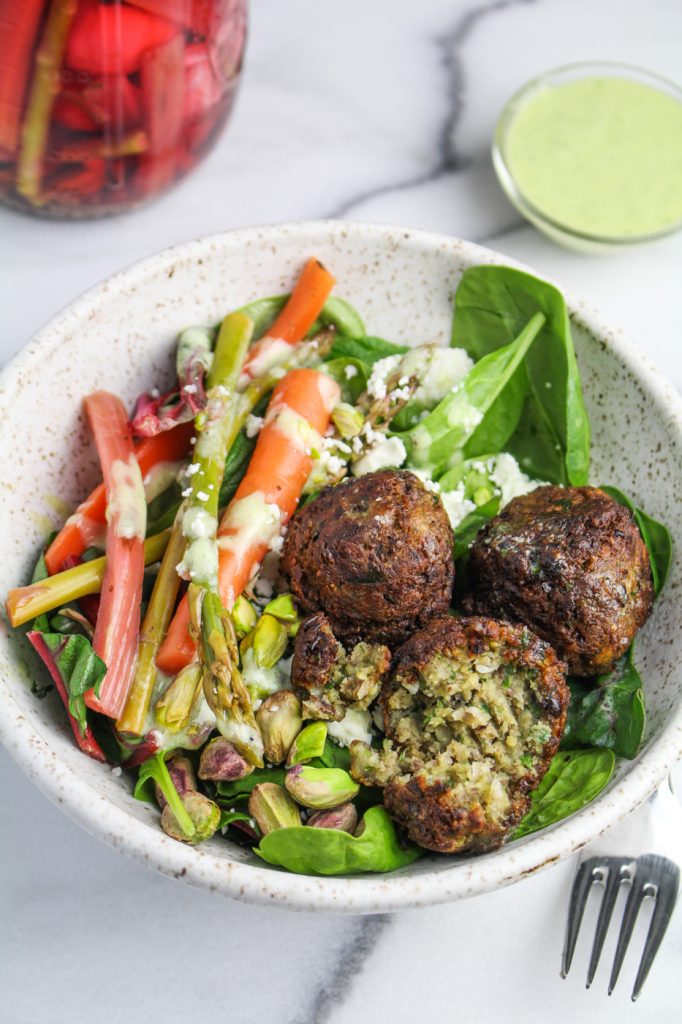

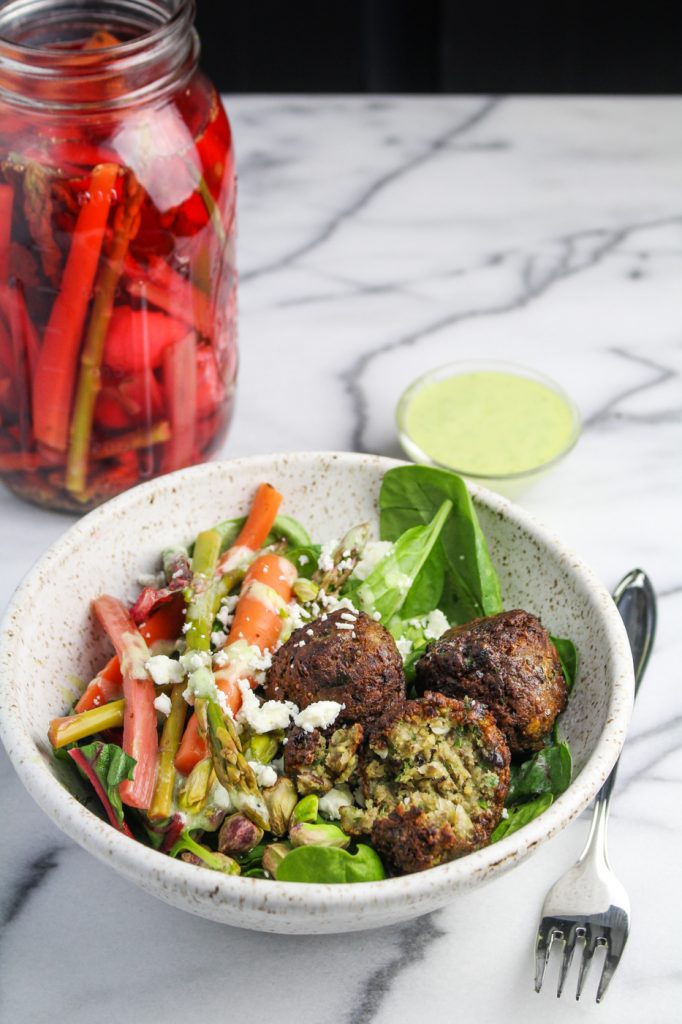
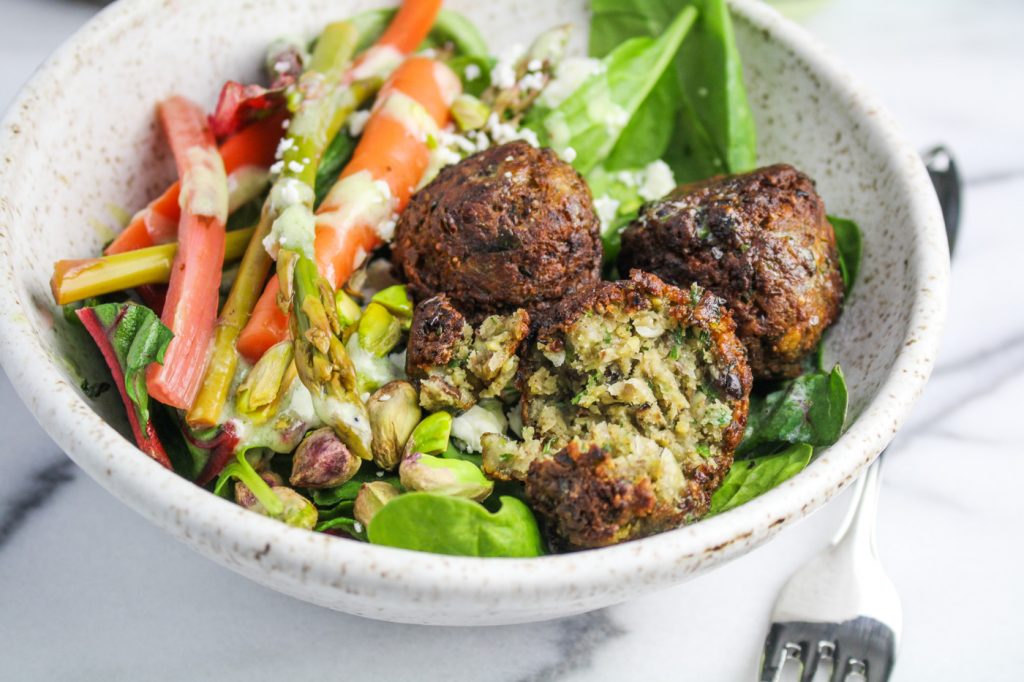

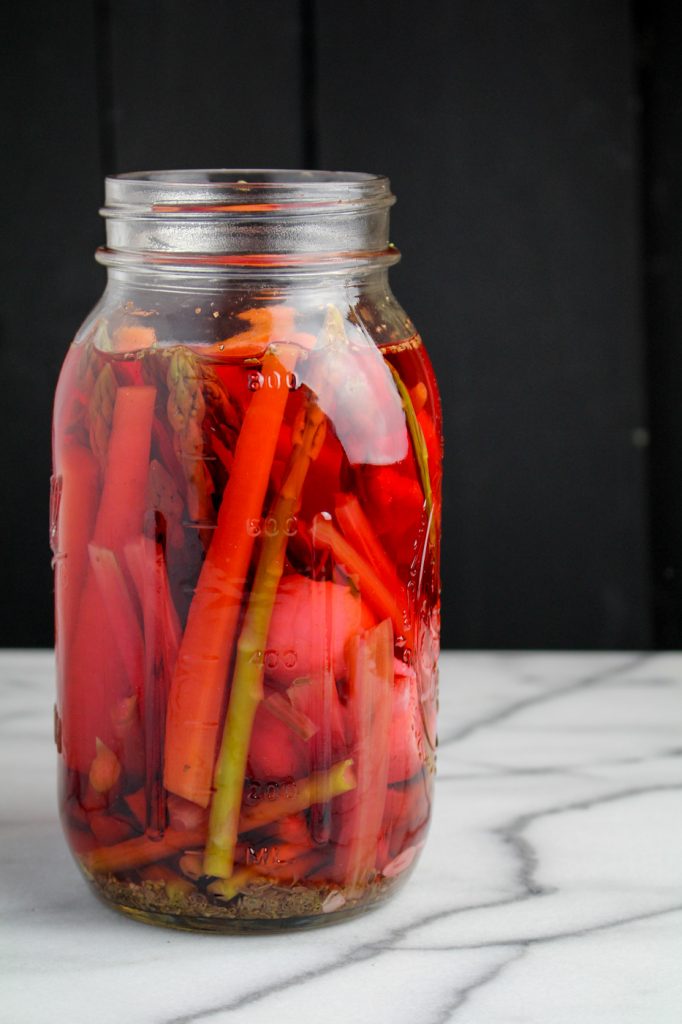
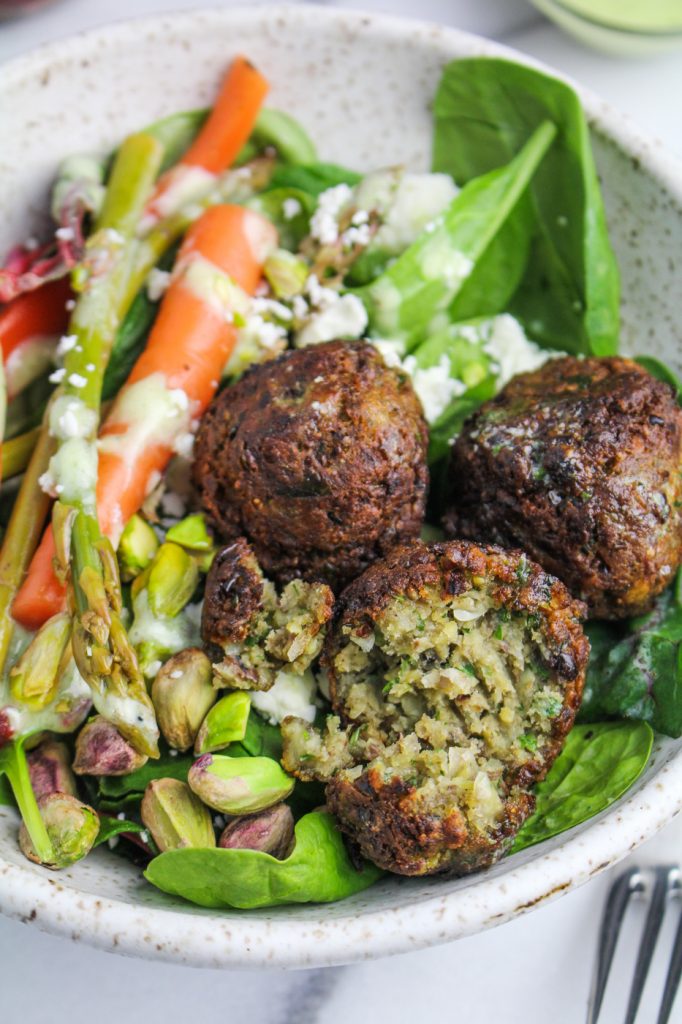
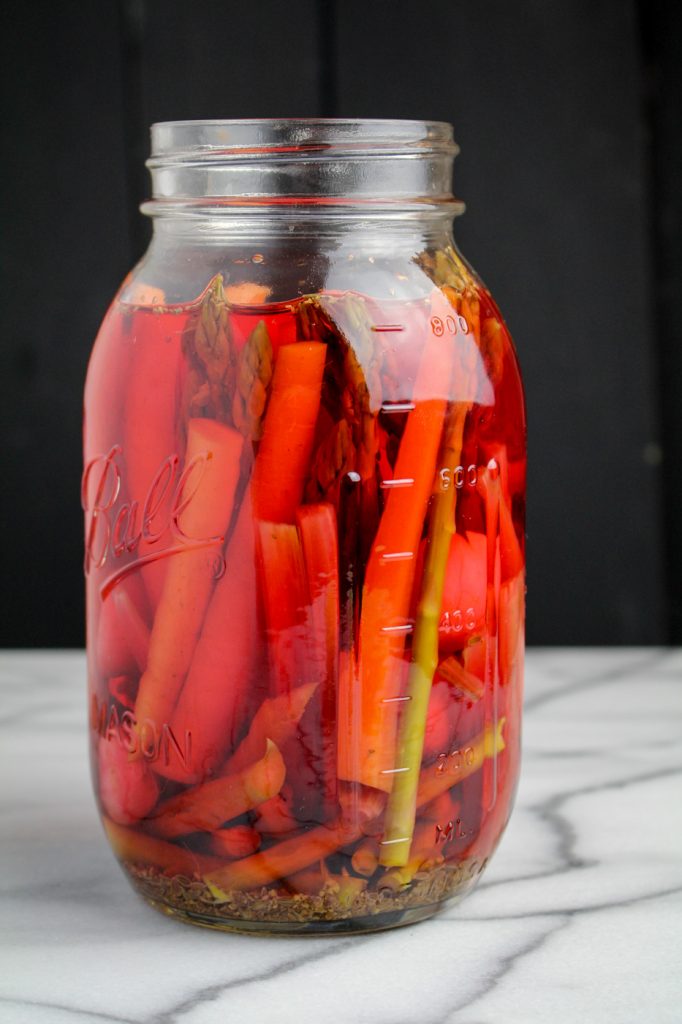

Leave a Reply